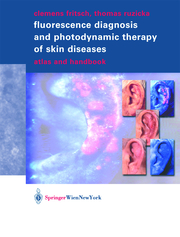-
Zusatztext
-
InhaltsangabeIntroduction and Historical Landmarks Definition of the Photodynamic Action Optimum Photosensitizing Agent for Photodynamic Action Definition of Fluorescence Detection with ALA Induced Porphyrins (FDAP) Mechanisms of Action in PDT dAminolevulinic Acid (ALA) Chemistry of ALA and ALA Methylester (ALA) Metabolism of ALA Pharmacodynamics of ALA Light Used in FDAP and PDT Unresolved Issues ind FDAP and PDT Fluorescence Detection of ALA-induced Porphyrins (FDAP) FDAP: Evaluation of the ALAInduced Fluoresence in Skin Diseases Ex vivo Investigations on ALAinduced Porphyrins Porphyrin Accumulation in Cells (in vitro) Porphyrin Accumulation in Skin Tumors, Colon and Bronchial Carcinomas after Administration of ALA (ex vivo) In vivo Investigations on ALAInduced Porphyrin/FDAP FDAP: Kinetics of ALAinduced Porphyrins in Human Cutaneous Tumors, Psoriasis Lesions and Normal Skin FDAP: Kinetics of PorphyrinAccumulation in Solar Keratoses: ALA versus ALA Methylester FDAP: use of the in vivo Fluorescence for Surgical Planning FDAP: Evaluation of the Optimum Photosensitizing Substance or its Prodrug FDAP: Evaluation of the Optimum Exciting Light Source FDAP: Correlation of in vivo Tumor Fluorescence and Histopathology FDAP: Course of FDAP in Relation to the Number of PDTSessions The Clinical Use of FDAP FDAP in Clinically Welldefined Tumors FDAP in Clinically Illdefined Lesions FDAP in Pretreated or Damaged Skin Limitations of FDAP Usefulness of FDAP in Guiding Tumor Therapies Photodynamic Therapy in Cutaneous Diseases PDT: Evaluation of the Efficacy in Solar Keratoses PDT: Evaluation of the Efficacy in Bowen`s Disease PDT: Evaluation of the Efficacy in Basal Cell Carcinoma PDT: Evaluation of the Efficacy Sqamous Cell Carcinoma PDT: Evaluation of the Efficacy in Psoriatric Lesions PDT: Evaluation of the Efficacy in Selected Cutaneous Diseases PDT in Skin Cancers and Precanceroses Others than Discussed Above PDT in Tumors of the Oral Mucosa PDT in Nonneoplastic Skin Diseases PDT in Nondermatological Indications PDT: Evaluation of the Optimum Photosensitizing Substance or its Prodrug PDT: Evaluation of the Optimum Exciting Light Source General Discussion FDAP: Indications and Limits PDT: Indications and Limits Safety and Tolerability of ALAPDT Regulatory Affairs Concerning Aminolevulinic Acid Regulatory Affairs Concerning Aminolevulinic Acid Methylester Conclusion Summary
-
-
Kurztext
-
The first comprehensive collection of fluorescence diagnosis (FDAP) and photodynamic therapy (PDT)Unique atlas of over 270 high quality color photographiesGuidelines for the practical use of FDAP and PDT in dermatology
-
-
Schlagzeile
- InhaltsangabeIntroduction and Historical Landmarks - Definition of the Photodynamic Action - Optimum Photosensitizing Agent for Photodynamic Action - Definition of Fluorescence Detection with ALA- Induced Porphyrins (FDAP) - Mechanisms of Action in PDT d-Aminolevulinic Acid (ALA) - Chemistry of ALA and ALA Methylester (ALA) - Metabolism of ALA - Pharmacodynamics of ALA Light Used in FDAP and PDT Unresolved Issues ind FDAP and PDT Fluorescence Detection of ALA-induced Porphyrins (FDAP) - FDAP: Evaluation of the ALA-Induced Fluoresence in Skin Diseases Ex vivo - Investigations on ALA-induced Porphyrins - Porphyrin Accumulation in Cells (in vitro) - Porphyrin Accumulation in Skin Tumors, Colon and Bronchial Carcinomas after Administration of ALA (ex vivo) In vivo - Investigations on ALA-Induced Porphyrin/FDAP - FDAP: Kinetics of ALA-induced Porphyrins in Human Cutaneous Tumors, Psoriasis Lesions and Normal Skin - FDAP: Kinetics of PorphyrinAccumulation in Solar Keratoses: ALA versus ALA Methylester - FDAP: use of the in vivo - Fluorescence for Surgical Planning - FDAP: Evaluation of the Optimum Photosensitizing Substance or its Prodrug - FDAP: Evaluation of the Optimum Exciting Light Source - FDAP: Correlation of in vivo - Tumor Fluorescence and Histopathology - FDAP: Course of FDAP in Relation to the Number of PDT-Sessions The Clinical Use of FDAP - FDAP in Clinically Well-defined Tumors - FDAP in Clinically Ill-defined Lesions - FDAP in Pretreated or Damaged Skin - Limitations of FDAP - Usefulness of FDAP in Guiding Tumor Therapies Photodynamic Therapy in Cutaneous Diseases - PDT: Evaluation of the Efficacy in Solar Keratoses - PDT: Evaluation of the Efficacy in Bowen`s Disease - PDT: Evaluation of the Efficacy in Basal Cell Carcinoma - PDT: Evaluation of the Efficacy Sqamous Cell Carcinoma - PDT: Evaluation of the Efficacy in Psoriatric Lesions - PDT: Evaluation ofthe Efficacy in Selected Cutaneous Diseases - PDT in Skin Cancers and Precanceroses Others than Discussed Above - PDT in Tumors of the Oral Mucosa - PDT in Non-neoplastic Skin Diseases - PDT in Non-dermatological Indications - PDT: Evaluation of the Optimum Photosensitizing Substance or its Prodrug - PDT: Evaluation of the Optimum Exciting Light Source General Discussion - FDAP: Indications and Limits - PDT: Indications and Limits - Safety and Tolerability of ALA-PDT - Regulatory Affairs Concerning Aminolevulinic Acid - Regulatory Affairs Concerning Aminolevulinic Acid Methylester Conclusion Summary
Detailansicht
Fluorescence Diagnosis and Photodynamic Therapy of Skin Diseases
Handbook and Atlas
ISBN/EAN: 9783211838273
Umbreit-Nr.: 480504
Sprache:
Englisch
Umfang: VII, 128 S., 266 farbige Illustr.
Format in cm:
Einband:
gebundenes Buch
Erschienen am 17.06.2003


